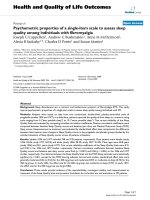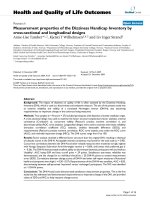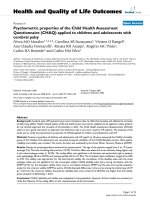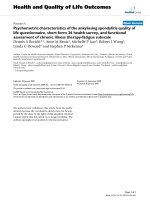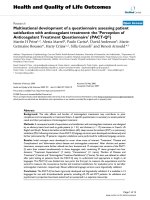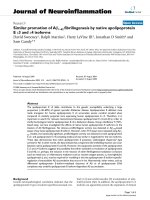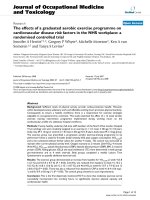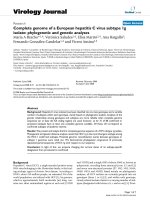báo cáo hóa học: " Psychometric properties of a single-item scale to assess sleep quality among individuals with fibromyalgia" potx
Bạn đang xem bản rút gọn của tài liệu. Xem và tải ngay bản đầy đủ của tài liệu tại đây (230.26 KB, 7 trang )
BioMed Central
Page 1 of 7
(page number not for citation purposes)
Health and Quality of Life Outcomes
Open Access
Research
Psychometric properties of a single-item scale to assess sleep
quality among individuals with fibromyalgia
Joseph C Cappelleri
1
, Andrew G Bushmakin
1
, Anne M McDermott
2
,
Alesia B Sadosky*
3
, Charles D Petrie
1
and Susan Martin
4
Address:
1
Pfizer Inc, Global Research and Development, 50 Pequot Avenue, New London, Connecticut 06320, USA,
2
Outcomes Research
Consultant, 13104 Riviera Terrace, Silver Spring, Maryland 20904, USA,
3
Pfizer Inc., Global Outcomes Research, 235 East 42nd Street, New York,
New York 10017, USA and
4
Pfizer Inc, Global Outcomes Research, 2800 Plymouth Road, Ann Arbor, Michigan 48105, USA
Email: Joseph C Cappelleri - ; Andrew G Bushmakin - ;
Anne M McDermott - ; Alesia B Sadosky* - ;
Charles D Petrie - ; Susan Martin -
* Corresponding author
Abstract
Background: Sleep disturbances are a common and bothersome symptom of fibromyalgia (FM). This study
reports psychometric properties of a single-item scale to assess sleep quality among individuals with FM.
Methods: Analyses were based on data from two randomized, double-blind, placebo-controlled trials of
pregabalin (studies 1056 and 1077). In a daily diary, patients reported the quality of their sleep on a numeric rating
scale ranging from 0 ("best possible sleep") to 10 ("worst possible sleep"). Test re-test reliability of the Sleep
Quality Scale was evaluated by computing intraclass correlation coefficients. Pearson correlation coefficients were
computed between baseline Sleep Quality scores and baseline pain diary and Medical Outcomes Study (MOS)
Sleep scores. Responsiveness to treatment was evaluated by standardized effect sizes computed as the difference
between least squares mean changes in Sleep Quality scores in the pregabalin and placebo groups divided by the
standard deviation of Sleep Quality scores across all patients at baseline.
Results: Studies 1056 and 1077 included 748 and 745 patients, respectively. Most patients were female (study
1056: 94.4%; study 1077: 94.5%) and white (study 1056: 90.2%; study 1077: 91.0%). Mean ages were 48.8 years
(study 1056) and 50.1 years (study 1077). Test re-test reliability coefficients of the Sleep Quality Scale were 0.91
and 0.90 in the 1056 and 1077 studies, respectively. Pearson correlation coefficients between baseline Sleep
Quality scores and baseline pain diary scores were 0.64 (p < 0.001) and 0.58 (p < 0.001) in the 1056 and 1077
studies, respectively. Correlations between the Sleep Quality Scale and the MOS Sleep subscales were statistically
significant (p < 0.01), except for the MOS Snoring subscale. Across both studies, standardized effect sizes were
generally moderate (0.46 to 0.52) for the 300 mg group and moderate (0.59) or moderate-to-large (0.70) for the
450 mg group. In study 1056, the effect size for the 600 mg group was moderate-to-large (0.73). In study 1077,
the effect size for the 600 mg group was large (0.82).
Conclusion: These results provide evidence of the reproducibility, convergent validity, and responsiveness to
treatment of the Sleep Quality Scale and provide a foundation for its further use and evaluation in FM patients.
Published: 17 June 2009
Health and Quality of Life Outcomes 2009, 7:54 doi:10.1186/1477-7525-7-54
Received: 4 December 2008
Accepted: 17 June 2009
This article is available from: />© 2009 Cappelleri et al; licensee BioMed Central Ltd.
This is an Open Access article distributed under the terms of the Creative Commons Attribution License ( />),
which permits unrestricted use, distribution, and reproduction in any medium, provided the original work is properly cited.
Health and Quality of Life Outcomes 2009, 7:54 />Page 2 of 7
(page number not for citation purposes)
Background
The American College of Rheumatology (ACR) defines
fibromyalgia syndrome (FM) using two criteria: (1)
chronic widespread pain and (2) pain upon digital palpa-
tion in at least 11 of 18 defined tender point sites [1,2].
Common co-morbid symptoms associated with FM
include sleep disturbances, fatigue, morning stiffness,
affective disorders, chronic daily headache, dyscognition,
irritable bowel syndrome, and irritable bladder [3]. In a
series of focus group and ranking exercises, clinical experts
and patients agreed that while pain is the cardinal symp-
tom of FM, it is important to also assess fatigue, impact on
sleep, health-related quality of life, depression, and cogni-
tive difficulties [4]. Assessing the effectiveness of new ther-
apies therefore requires accurate assessment of a multi-
dimensional array of symptoms and problems.
This paper focuses on the measurement of sleep problems
in patients with FM. Disturbed sleep is consistently
ranked by patients as a highly bothersome symptom of
the disease [5,6]. While FM patients report that pain inter-
feres with their sleep, recent studies also suggest a recipro-
cal relationship. Specifically, sleep quality is predictive of
pain as well as broader areas of functioning and emo-
tional well-being such as fatigue, social functioning, and
depression [7,8].
While multiple-item, patient-reported surveys are availa-
ble to measure specific sleep problems, single-item assess-
ments of overall sleep quality provide a useful summary
measure and are frequently included in research on FM
[9]. Single-item sleep quality assessments allow patients
to implicitly weight the various components of sleep that
are important to them and assign an overall rating based
on their individual rankings and experiences. While rank-
ings and experiences will vary, it is likely that there is a
common set of key components that constitute overall
sleep quality. A recent study of the subjective meaning of
sleep quality among individuals with insomnia and nor-
mal sleepers found that both groups similarly defined
sleep quality as tiredness on waking and throughout the
day, feeling rested and restored on waking, and the
number of awakenings experienced in the night [10].
Single-item sleep quality assessments are practical when
measurements are taken at frequent intervals, such as in
patient diaries that are completed every day. Sleep diaries
are reliable and valid assessments for capturing such
patient-reported outcomes and reduce recall bias since
they are collected on a daily basis [11]. This study reports
psychometric properties of a single-item Sleep Quality
numeric rating scale completed by FM patients daily in
two clinical trials.
Methods
Study design and subjects
This paper reports the psychometric properties of the daily
diary Sleep Quality Scale using data from two rand-
omized, double-blind, placebo-controlled clinical trials of
pregabalin conducted in the United States (US), referred
to here as studies 1056 [12] and 1077 [13]. The study
designs for these trials have been described elsewhere
[12,13]. The studies were randomized, double-blind, and
placebo-controlled clinical trials of three doses of pregab-
alin (300 mg/day, 450 mg/day, and 600 mg/day). Patients
were 18 years of age or older with FM as defined by the
ACR criteria [1,2].
During the baseline phase, study patients had to have an
average daily diary pain score of at least 4 (within the last
7 days) on a numeric rating scale ranging from 0 ("no
pain") to 10 ("worst possible pain"). Further, study
patients had to have a score of at least 40 mm on the 100
mm visual analogue scale (VAS) of the Short-Form McGill
Pain Questionnaire [14] at the screening and baseline
(randomization) study visits. In study 1077, patients with
a 30% or greater reduction in the VAS from the screening
to the randomization study visits (a single-blind placebo
run-in period) were discontinued; this criterion in study
1077 was intended to exclude potential placebo respond-
ers. In both studies, the primary efficacy measure was end-
point mean pain score defined as the mean of the last 7
pain diary entries while the patient was on study medica-
tion.
The Sleep Quality Scale
In the daily diary assessment, patients reported the quality
of their sleep over the past 24 hours on an 11-point
numeric rating scale ranging from 0 ("best possible
sleep") to 10 ("worst possible sleep"). Patients were
instructed to complete the scale in the morning upon
awakening. The baseline scores were computed as the
average rating over the 7 days prior to taking study medi-
cation. The end of treatment score was computed as the
average rating over the last 7 days during which the
patient was receiving study medication. Since higher
scores indicate poorer sleep, negative change scores (end
of treatment score minus baseline score) indicate
improvement.
The MOS Sleep Scale
The studies also included a validated sleep survey, the
MOS Sleep Scale [15-17]. The MOS Sleep Scale provided
6 subscale scores (Sleep Disturbance, Snoring, Awakening
Short of Breath or with a Headache, Quantity of Sleep,
Sleep Adequacy, and Somnolence) and an overall Sleep
Problems Index score [15]. The Quantity of Sleep subscale
score documented the number of hours of sleep per night
(possible range from 0 to 24 hours). The remaining scale
Health and Quality of Life Outcomes 2009, 7:54 />Page 3 of 7
(page number not for citation purposes)
scores ranged from 0 to 100 where higher scores indicated
greater sleep dysfunction, except for the Sleep Adequacy
subscale where higher scores reflected more adequate
sleep.
Statistical methods
Test re-test reliability and convergent validity analyses of
the Sleep Quality Scale were obtained from all available
study patients across all treatment groups. Test re-test reli-
ability of the Sleep Quality scores were evaluated using
pre-treatment data. Intraclass correlation coefficients
(ICC) based on the daily assessments were computed and
the Spearman-Brown Prophecy formula was used to cal-
culate the reliability of the Sleep Quality score (average of
7 daily assessments) [18,19]. Reliability coefficients less
than or equal to 0.70 were considered unacceptable; coef-
ficients between 0.70 and 0.90 were considered accepta-
ble; and coefficients of 0.90 or higher were considered
excellent levels of test re-test reliability [20].
Convergent validity analyses were evaluated using base-
line data. Baseline Sleep Quality scores were correlated
with baseline pain diary and baseline MOS Sleep scores
using Pearson correlation coefficients.
Treatment effects on the Sleep Quality Scale have been
reported previously [12,13]. Treatment effects were based
on analysis of covariance (ANCOVA) models of end-of-
treatment Sleep Quality scores with treatment and center
as factors and corresponding baseline Sleep Quality scores
as covariates. The model-estimated least square mean
change scores by treatment group were used in these anal-
yses to compute effect sizes. Specifically, standardized
effect sizes were computed as the difference between least
squares mean changes in Sleep Quality scores in the pre-
gabalin and placebo groups divided by the standard devi-
ation of Sleep Quality scores across all patients at
baseline. These effect sizes were interpreted (in absolute
value) as follows: trivial (less than or equal to 0.20), small
(0.20), moderate (0.50) and large (0.80) [21].
Results
Studies 1056 and 1077 included 748 and 745 patients,
respectively. Most patients were female (94.4% in study
1056 and 94.5% in study 1077) and white (90.2% in
study 1056 and 91.0% in study 1077) (Table 1). In study
1056, the mean age of patients was 48.8 years and the
average duration of FM was 9 years. In study 1077, the
mean age of patients was 50.1 years and the average dura-
Table 1: Baseline patient characteristics and sleep scores
Characteristics Study 1056 (N = 748) Study 1077 (N = 745)
n%n%
Gender
Male 42 5.6 41 5.5
Female 706 94.4 704 94.5
Race
White 675 90.2 678 91.0
Black 35 4.7 33 4.4
Other 38 5.1 34 4.6
N Mean ± SD N Mean ± SD
Age (years) 748 48.8 ± 10.9 745 50.1 ± 11.4
Duration of FM Prior to Study Start (months) 747 111.7 ± 95.0 745 120.2 ± 96.2
Number of Painful Tender Points
a
719 17.1 ± 1.6 723 16.9 ± 1.8
Baseline Mean Pain Score
b
748 7.1 ± 1.3 745 6.7 ± 1.3
Sleep Quality Scale
b
748 6.7 (1.7) 745 6.2 (1.6)
MOS Sleep Scales
Sleep Disturbance 744 67.8 ± 23.4 740 60.0 ± 24.9
Snoring 726 40.6 ± 35.9 717 36.7 ± 34.6
Awaken Short of Breath or with Headache 744 37.6 ± 31.1 743 32.3 ± 32.0
Quantity of Sleep 747 5.4 ± 1.6 744 5.6 ± 1.6
Sleep Adequacy 745 20.6 ± 22.0 744 23.7 ± 23.2
Somnolence 743 50.3 ± 24.1 740 42.1 ± 23.1
Sleep Problems Index (9-item) 741 65.0 ± 16.3 736 58.3 ± 17.7
SD = Standard Deviation
a
Total number of tender points with value >0 at randomization; the number is missing if any of 18 tender points is missing.
b
Baseline = Last 7 available pain scores before taking study medication up to and including Day1. If fewer than 7 scores are available then baseline
consists of all scores that are available.
Health and Quality of Life Outcomes 2009, 7:54 />Page 4 of 7
(page number not for citation purposes)
tion of FM was 10 years. In both studies, baseline mean
pain scores were approximately 7 on a scale from 0 ("no
pain") to 10 ("worst possible pain").
Test re-test reliability coefficients of the pre-treatment
Sleep Quality scores, averaged over seven daily measure-
ments prior to study medication, were 0.91 and 0.90 in
the 1056 and 1077 studies, respectively (Table 2). Relia-
bility coefficients of this magnitude suggested excellent
reproducibility [20].
Pearson correlation coefficients between baseline Sleep
Quality scores and baseline average daily diary pain scores
were 0.64 (p < 0.001) and 0.58 (p < 0.001) in the 1056
and 1077 studies, respectively (Table 3). Correlations
between the Sleep Quality and the MOS Sleep Scale sub-
scales were statistically significant (p < 0.01), except for
the MOS Snoring subscale where no correlation was
expected (Table 3). Correlations were largest for the MOS
Sleep Disturbance subscale: 0.45 (p < 0.001) and 0.42 (p
< 0.001) in studies 1056 and 1077, respectively (Table 3).
As reported previously, all three doses of pregabalin were
associated with statistically significantly greater improve-
ments in sleep quality relative to placebo in both the 1056
[12] and 1077 [13] studies. Our current analysis facilitates
the interpretation of the magnitude of those treatment dif-
ferences by reporting effect sizes that were evaluated rela-
tive to accepted benchmarks. Across both studies,
standardized effect sizes were generally moderate (0.46 to
0.52) for the 300 mg group and moderate (0.59) or mod-
erate-to-large (0.70) for the 450 mg group (Table 4). In
study 1056, the effect size for the 600 mg group was mod-
erate-to-large (0.73). In study 1077, the effect size for the
600 mg group was large (0.82).
Discussion
These results suggest that the Sleep Quality Scale has favo-
rable measurement properties. Consistent with the clini-
cal profile of FM, patients' baseline MOS Sleep scores were
substantially poorer than the general population values
on MOS Sleep scores for Sleep Disturbance (24.5), Snor-
ing (28.3), Awaken Short of Breath or with Headache
(9.5), Quantity of Sleep (6.8 hours), Somnolence (21.9),
and Sleep Problems Index II (25.8) [16,17]. Test re-test
reliability of pre-treatment scores was excellent in both tri-
als. The Sleep Quality Scale was correlated with pain and
with relevant aspects of another sleep assessment, the
MOS Sleep Scale. Further, the Sleep Quality scale was
responsive to treatment effects.
The observed correlations between Sleep Quality scores
and pain (0.58 to 0.64) were large and larger than those
reported in previous FM studies (0.32 to 0.33) [7,8]. The
earlier studies used multi-item sleep quality and pain
scales, specifically the Pittsburgh Sleep Quality Index
(PSQI) to assess sleep quality and the McGill Pain Ques-
tionnaire [8] and SF-36 Bodily Pain scale [7] to assess
pain. In the current study, sleep quality and pain were
based on single-item, 11-point, numeric rating scales
reported by patients in daily diaries.
While these findings support continued applications of
the Sleep Quality Scale in FM, we note three areas for fur-
ther research. First, this study does not address how FM
patients define sleep quality. While the p-values for the
Pearson correlation coefficient are restricted to the null
hypothesis of zero correlation, not to the strength of the
correlation, the magnitude of the correlations between the
Sleep Quality Scale and the MOS Sleep Scale provides
some insights into the specific components of sleep that
these patients considered when evaluating the overall
quality of their sleep. Specifically, Sleep Quality showed a
moderate correlation with MOS Sleep Disturbance, which
includes questions about trouble falling asleep, the
amount of time to fall asleep, restlessness, and awakening
during sleep; a moderate correlation with MOS Quantity
of Sleep; a modest correlation with MOS Sleep Adequacy;
a small correlation with MOS Somnolence and MOS
Awaken Short of Breath or with Headache; and no corre-
lation with MOS Snoring. Qualitative research among FM
patients is underway to confirm these findings and to fur-
ther understand how FM patients evaluate sleep quality.
Second, these clinical trial patients were experiencing
fairly high levels of pain and may not be necessarily rep-
resentative of all FM patient populations; although the
patients studied here embody many patients with FM.
Consistent with FM being more common in women
(3.4%) compared with men (0.5%) [22], the vast majority
Table 2: Test re-test reliability of pre-treatment Sleep Quality Scale scores
Study Between-Subjects Error
Variance
Within-Subject Error
Variance
ICC of a Single Daily Score ICC for the Average of Seven
Daily Scores
1056 2.40 1.68 0.59 0.91
1077 2.23 1.69 0.57 0.90
ICC = Intraclass Correlation Coefficient = (Between-Subjects Error Variance)/(Between-Subjects Error Variance + Within-Subject Error Variance)
ICC for the Average of Seven Daily Scores = 7(ICC for single score)/[1 + 6(ICC for a single score)]
Health and Quality of Life Outcomes 2009, 7:54 />Page 5 of 7
(page number not for citation purposes)
Table 3: Baseline correlations of the Sleep Quality Scale with pain and the MOS Sleep Scale
Pearson Correlation (r) with Sleep Quality Scale (-)
Study 1056 Study 1077
rp-valuerp-value
Average Daily Diary Pain Numeric Rating Scale (-) 0.64 <0.001 0.58 <0.001
MOS Sleep Scales
Sleep Disturbance (-) 0.45 <0.001 0.42 <0.001
Snoring (-) 0.01 0.884 0.00 0.993
Awaken Short of Breath or with Headache (-) 0.21 <0.001 0.14 <0.001
Quantity of Sleep (+) -0.31 <0.001 -0.34 <0.001
Sleep Adequacy (+) -0.21 <0.001 -0.32 <0.001
Somnolence (-) 0.11 0.004 0.15 <0.001
(-) Higher scale scores indicate poorer outcome. (+) Higher scale scores indicate better outcome.
Table 4: Treatment differences and effect sizes for the Sleep Quality Scale
Pregabalin Dose Group Treatment Comparison
(Pregabalin – Placebo)
a
Effect Size
a
Difference 95% CI p-value
Study 1056
300 mg -0.86 -1.30, -0.43 0.0001 -0.521
450 mg -0.97 -1.40, -0.53 <0.0001 -0.587
600 mg -1.21 -1.64, -0.77 <0.0001 -0.732
Study 1077
300 mg -0.73 -1.14, -0.31 0.0007 -0.458
450 mg -1.12 -1.54, -0.71 <0.0001 -0.703
600 mg -1.31 -1.73, -0.90 <0.0001 -0.822
CI = Confidence Interval
a
Higher Sleep Quality scores indicate poorer sleep quality. Therefore a negative difference between pregabalin and placebo and negative effect size
indicates a greater improvement in sleep quality for patients receiving pregabalin relative to those receiving placebo.
Health and Quality of Life Outcomes 2009, 7:54 />Page 6 of 7
(page number not for citation purposes)
of patients in this sample were women. Study patients
also had a long history of FM, averaging 9 to 10 years.
Therefore the clinical and demographic profiles of these
samples reflect those mainly of women with about a dec-
ade of experience with FM. Applications in real-world set-
tings and within subpopulations of patients, such as
children with FM [23], menopausal women with FM [24],
and those with newly diagnosed FM [25], would provide
additional insight into the impact of FM on sleep quality.
Finally, exploration of frequent comorbid conditions,
such as obstructive sleep apnea, and the co-variation of
sleep quality and pain merit further study [22,26,27].
Conclusion
This investigation is a psychometric analysis of a single-
item, overall rating of sleep quality for patients with FM.
Single-item scales reduce patient burden, particularly
when repeated assessments are necessary, such as for rat-
ings recorded in a daily diary. The results of this investiga-
tion suggest that the single-item Sleep Quality Scale has
favorable measurement properties; namely, these results
provide evidence of its reproducibility, convergent valid-
ity, and responsiveness to treatment as an overall rating of
sleep in two clinical trials. To assess specific areas of sleep,
the trials included a multi-item sleep assessment, the
MOS Sleep Scale, which also demonstrated favorable psy-
chometric properties in this setting [17]. This paper pro-
vides the foundation for further use and evaluation of the
Sleep Quality Scale in FM patients, for which sleep distur-
bances are a key complaint.
Competing interests
The research reported in this paper was funded by Pfizer
Inc. Drs. Cappelleri and Petrie and Mr. Bushmakin are
full-time employees of Pfizer Global Research and Devel-
opment, New London, CT. Dr. Sadosky is a full-time
employee of Pfizer Global Pharmaceuticals, Outcomes
Research, New York, NY. Ms. Martin, currently at RTI
Health Solutions, was a full-time employee of Pfizer Glo-
bal Research and Development, Outcomes Research, Ann
Arbor, MI, when this work was performed. Dr. McDer-
mott was a paid consultant to Pfizer in connection with
the development of this manuscript.
Authors' contributions
JCC and AGB made substantive contributions to the sta-
tistical analysis, interpretation of results, and drafting of
the manuscript. AM and ABS made substantive contribu-
tions in interpreting the analysis and helped to draft the
manuscript. SM and CDP made substantive contributions
to study design, conduct, and interpretation of results. All
authors read and approved the final manuscript.
References
1. Wolfe F, Smythe HA, Yunus MB, Bennett RM, Bombardier C, Gold-
enberg DL, Tugwell P, Campbell SM, Abeles M, Clark P, Fam AG, Far-
ber SJ, Fletchner JJ, Franklin CM, Gatter RA, Hamaty D, Lessard J,
Lichtbroun AS, Masi AT, McCain GA, Reynolds WJ, Romano TJ, Rus-
sell IJ, Sheon RP: The American College of Rheumatology 1990
Criteria for the Classification of Fibromyalgia. Report of the
Multicenter Criteria Committee. Arthritis Rheum 1990,
33:160-72.
2. Wolfe F: The epidemiology of fibromyalgia. J Musculoskeletal
Pain 1993, 1:137-48.
3. Wolfe F, Ross K, Anderson J, Russell IJ, Hebert L: The prevalence
and characteristics of fibromyalgia in the general population.
Arthritis Rheum 1995, 38:19-28.
4. Mease PJ, Arnold LM, Crofford LJ, Williams DA, Russell IJ, Humphrey
L, Abetz L, Martin SA: Identifying the clinical domains of fibro-
myalgia: Contributions from the clinician and patient Delphi
exercises. Arthritis Rheum 2008, 59:952-960.
5. Bennett RM, Jones J, Turk DC, Matallana L: An internet survey of
2,596 people with fibromyalgia. BMC Musculoskelet Disord 2007,
8:27.
6. Mease P, Arnold LM, Bennett R, Boonen A, Buskila D, Carville S,
Chappell A, Choy E, Clauw D, Dadabhoy D, Gendreau M, Golden-
berg D, Litlejohn G, Martin S, Perera P, Russell IJ, Simon L, Spaeth M,
Williams D, Crofford L: Fibromyalgia syndrome. J Rheumatol
2007, 34:1415-25.
7. Theadom A, Cropley M, Humphrey KL: Exploring the role of
sleep and coping in quality of life in fibromyalgia. J Psychosom
Res 2007, 62:145-51.
8. Bigatti SM, Hernandez AM, Cronan TA, Rand KL: Sleep distur-
bances in fibromyalgia syndrome: Relationship to pain and
depression. Arthritis Rheum 2008, 59:961-967.
9. White KP, Harth M: An analytical review of 24 controlled clin-
ical trials for fibromyalgia syndrome. Pain 1996, 64:211-219.
10. Harvey AG, Stinson K, Whitaker KL, Moskovitz D, Virk H: The sub-
jective meaning of sleep quality: a comparison of individuals
with and without insomnia. Sleep 2008, 31:
383-93.
11. Haythornthwaite JA, Hegel MT, Kerns RD: Development of a
sleep diary for chronic pain patients. Journal of Pain and Symptom
Management 1991, 6:65-72.
12. Mease PJ, Russell IJ, Arnold LM, Florian H, Young JP, Martin SA,
Sharma U: A randomized, double-blind, placebo-controlled,
phase III trial of pregabalin in the treatment of patients with
fibromyalgia. J Rheumatol 2008, 35:502-14.
13. Arnold LM, Russell IJ, Diri EW, Duan WR, Young JP, Sharma U, Martin
SA, Barrett JA, Haig G: A 14-week, randomized, double-blind,
placebo-controlled monotherapy trial of pregabalin in
patients with fibromyalgia. J Pain 2008, 9:792-805.
14. Melzack R: The short-form McGill Pain Questionnaire. Pain
1987, 30:191-97.
15. Hays R, Stewart A: Sleep measures. In Measuring Functioning and
Well-Being: the Medical Outcomes Study Approach Edited by: Stewart A,
Ware J. Durham, NC: Duke University Press; 1992:235-259.
16. Hays RD, Martin SA, Sesti AM, Spritzer KL: Psychometric proper-
ties of the Medical Outcomes Study Sleep measure. Sleep
Med 2005, 6:41-44.
17. Cappelleri JC, Bushmakin AG, McDermott AM, Dukes E, Sadosky A,
Petrie CD, Martin S: Measurement properties of the Medical
Outcomes Study Sleep Scale in patients with fibromyalgia.
Sleep Medicine 2009 in press.
18. Singer J: Using SAS PROC MIXED to fix multilevel models,
hierarchical models, and individual growth models. Journal of
Educational and Behavioural Statistics 1998, 24:323-55.
19. Fleiss JL: The Design and Analysis of Clinical Experiments New York:
Wiley; 1986.
20. Nunnally JC, Bernstein IH: Psychometric Theory New York: McGraw-
Hill; 1994.
21. Cohen J: Statistical Analysis for the Behavioral Sciences Second edition.
Hillsdale, NJ: Lawrence Erlbaum Associates; 1988.
22. Abad V, Sarinas P, Guilleminault C: Sleep and rheumatologic dis-
orders. Sleep Med Rev 2008, 12:211-228.
23. Varni J, Limbers C, Burwinkle T: Impaired health-related quality
of life in children and adolescents with chronic conditions: a
comparative analysis of 10 disease clusters and 33 disease
categories/severities utilizing the PedsQL™ 4.0 Generic
Core Scales. Health Qual Life Outcomes 2007, 5:43.
Publish with BioMed Central and every
scientist can read your work free of charge
"BioMed Central will be the most significant development for
disseminating the results of biomedical research in our lifetime."
Sir Paul Nurse, Cancer Research UK
Your research papers will be:
available free of charge to the entire biomedical community
peer reviewed and published immediately upon acceptance
cited in PubMed and archived on PubMed Central
yours — you keep the copyright
Submit your manuscript here:
/>BioMedcentral
Health and Quality of Life Outcomes 2009, 7:54 />Page 7 of 7
(page number not for citation purposes)
24. Eichling P, Sahni J: Menopause related sleep disorders. J Clin
Sleep Med 2005, 1:291-300.
25. Annemans L, Wessely S, Spaepen E, Caekelbergh K, Caubere JP, Le
Lay K, Taieb C: Health economic consequences related to the
diagnosis of fibromyalgia syndrome. Arthritis Rheum 2008,
58:895-902.
26. Delgado J, Murali G, Goldberg R: Sleep disorders in fibromyalgia.
Sleep 2004, 27:A339.
27. Khan S, Goldberg R, Haber A: Sleep disorders in fibromyalgia.
Sleep 2005, 28:A290.
